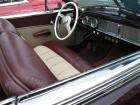|
Re: 1940 110 Compression
|
||||
|---|---|---|---|---|
|
Forum Ambassador

|
And typically one records the value after three compression strokes which typically are enough to reach a maximum value.
Posted on: 2008/9/18 8:59
|
|||
|
||||
|
Re: 1940 110 Compression
|
||||
|---|---|---|---|---|
|
Home away from home

|
Also keep the throttle blade at least close to wide open too. Are u at high altitude???
Posted on: 2008/9/18 10:26
|
|||
|
||||
|
Re: 1940 110 Compression
|
||||
|---|---|---|---|---|
|
Home away from home

|
No, I am near the coast. So low altitude. I'll give it a go this weekend.
Posted on: 2008/9/18 18:17
|
|||
|
||||
|
Re: 1940 110 Compression
|
||||
|---|---|---|---|---|
|
Quite a regular

|
you probably can not spot a head-gasket leak with a compression test. The amount of air that can make a LOT of noise leaking out of a head-gasket leak is typically too small in volume to make much of a difference.
Unfortunately, Packard's engineers "missed the boat" on cyl. head hold-downs. Too far apart. Not enough of them. All Packards are prone to cyl. gasket failure (well, I dont know about the V-8's - other than tune-ups, never worked on one). Best way to avoid this, is reasonably frequent re-torquing of cyl. head hold-downs. Follow the head-tightening sequence in the shop manuals. When EVER you pull a cyl. head, check its face - Packard heads, both alum. and steel, are prone to warping. Any half-way decent machine shop can re-surface the cyl. head. You are NOT likely to find un-even-ness in a Packard block. I personally do not believe in gasket paste on cyl. heads. Not convinced it can stop a gasket leak under the pressure of combustion. When I replace a cyl. head, I just spray it with a light engine oil, so that when I tighten the head-bolts, the gasket will "crush and slip" nicely as the cyl. head comes down. Works for me.
Posted on: 2008/9/23 9:18
|
|||
|
||||









